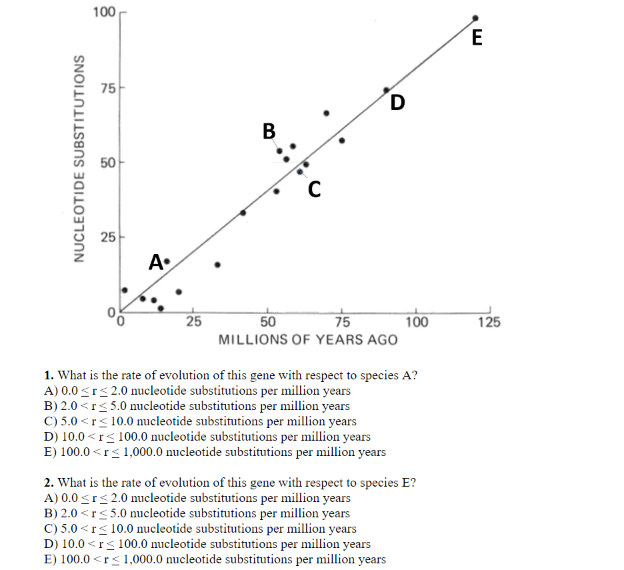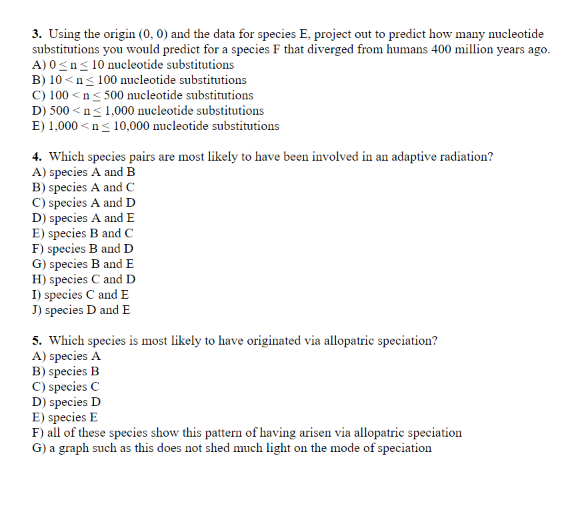Human Anatomy & Physiology (11th Edition)
11th Edition
ISBN:9780134580999
Author:Elaine N. Marieb, Katja N. Hoehn
Publisher:Elaine N. Marieb, Katja N. Hoehn
Chapter1: The Human Body: An Orientation
Section: Chapter Questions
Problem 1RQ: The correct sequence of levels forming the structural hierarchy is A. (a) organ, organ system,...
Related questions
Question
Graphical question on biology

Transcribed Image Text:100
E
75
B
50-
25
A.
25
75
MILLIONS OF YEARS AGO
50
100
125
1. What is the rate of evolution of this gene with respect to species A?
A) 0.0 <r< 2.0 nucleotide substitutions per million years
B) 2.0 <r< 5.0 nucleotide substitutions per million years
C) 5.0 <r< 10.0 mucleotide substitutions per million years
D) 10.0 <r< 100.0 nucleotide substitutions per million years
E) 100.0 <rs 1,000.0 nucleotide substitutions per million years
2. What is the rate of evolution of this gene with respect to species E?
A) 0.0 <rs 2.0 nucleotide substitutions per million years
B) 2.0 <rs 5.0 nucleotide substitutions per million years
C) 5.0 <r< 10.0 nucleotide substitutions per million years
D) 10.0 <rs 100.0 mucleotide substitutions per million years
E) 100.0 <rs 1,000.0 nucleotide substitutions per million years
NUCLEOTIDE SUBSTITUTIONS

Transcribed Image Text:3. Using the origin (0, 0) and the data for species E, project out to predict how many nucleotide
substitutions you would predict for a species F that diverged from humans 400 million years ago.
A) 0<ns 10 nucleotide substitutions
B) 10 <ng 100 nucleotide substitutions
C) 100 <n< 500 nucleotide substitutions
D) 500 <n< 1,000 nucleotide substitutions
E) 1,000 <n< 10,000 nucleotide substitutions
4. Which species pairs are most likely to have been involved in an adaptive radiation?
A) species A and B
B) species A and C
C) species A and D
D) species A and E
E) species B and C
F) species B and D
G) species B and E
H) species C and D
I) species C and E
J) species D and E
5. Which species is most likely to have originated via allopatric speciation?
A) species A
B) species B
C) species C
D) species D
E) species E
F) all of these species show this pattern of having arisen via allopatric speciation
G) a graph such as this does not shed much light on the mode of speciation
Expert Solution
This question has been solved!
Explore an expertly crafted, step-by-step solution for a thorough understanding of key concepts.
Step by step
Solved in 3 steps

Knowledge Booster
Learn more about
Need a deep-dive on the concept behind this application? Look no further. Learn more about this topic, biology and related others by exploring similar questions and additional content below.Recommended textbooks for you

Human Anatomy & Physiology (11th Edition)
Biology
ISBN:
9780134580999
Author:
Elaine N. Marieb, Katja N. Hoehn
Publisher:
PEARSON

Biology 2e
Biology
ISBN:
9781947172517
Author:
Matthew Douglas, Jung Choi, Mary Ann Clark
Publisher:
OpenStax

Anatomy & Physiology
Biology
ISBN:
9781259398629
Author:
McKinley, Michael P., O'loughlin, Valerie Dean, Bidle, Theresa Stouter
Publisher:
Mcgraw Hill Education,

Human Anatomy & Physiology (11th Edition)
Biology
ISBN:
9780134580999
Author:
Elaine N. Marieb, Katja N. Hoehn
Publisher:
PEARSON

Biology 2e
Biology
ISBN:
9781947172517
Author:
Matthew Douglas, Jung Choi, Mary Ann Clark
Publisher:
OpenStax

Anatomy & Physiology
Biology
ISBN:
9781259398629
Author:
McKinley, Michael P., O'loughlin, Valerie Dean, Bidle, Theresa Stouter
Publisher:
Mcgraw Hill Education,

Molecular Biology of the Cell (Sixth Edition)
Biology
ISBN:
9780815344322
Author:
Bruce Alberts, Alexander D. Johnson, Julian Lewis, David Morgan, Martin Raff, Keith Roberts, Peter Walter
Publisher:
W. W. Norton & Company

Laboratory Manual For Human Anatomy & Physiology
Biology
ISBN:
9781260159363
Author:
Martin, Terry R., Prentice-craver, Cynthia
Publisher:
McGraw-Hill Publishing Co.

Inquiry Into Life (16th Edition)
Biology
ISBN:
9781260231700
Author:
Sylvia S. Mader, Michael Windelspecht
Publisher:
McGraw Hill Education